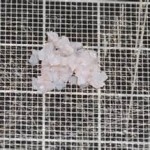Cartilage grafting to the nose for significant dorsal augmentation almost always requires a rib graft for the volume needed. A rib graft provides ample amounts of graft material to augment the nose to just about any degree but it does have a well known tendency for warping. Even a well carved and positioned rib graft placed on the nasal dorsum does not always guarantee that it will forever remain perfectly straight.

But to successfully place a diced cartilage graft into the nose, the many small cartilage ‘cubes’ must be placed into some type of containment sac to create a moldable cartilage graft. This has historically been done with the use of a Surgicel wrapping. Surgicel is best known as a hemostatic agent that was introduced long ago in 1947. It is composed of an oxidized cellulose polymer and comes as a very pliable mesh sheet. It can be rolled into a ‘sausage casing’ to contain a diced cartilage graft.

In the August 2011 issue of the Journal of Plastic, Reconstructive & Aesthetic Surgery, a study was reported whose aim was to compare the viability of diced cartilage wrapped in autogenous fascia to diced cartilage wrapped in AlloDerm in a rabbit model. Diced cartilage grafts wrapped in lumbar fascia vs Alloderm were compared after six months of implantation by standard and immunohistochemical staining. Their histological analysis showed that the chondrocyte regeneration potential, matrix collagen content, and metaplastic bone formation of the AlloDerm-treated group were significantly superior to those of the fascia-treated group. With respect to other histological parameters, the AlloDerm-treated group showed better results than the fascia-treated group, but these results were not statistically significant. Their experimental results indicate that AlloDerm may be an excellent material for diced cartilage grafting. At the least, it appears as if it is just as good as autogenous fascia.
While this was a limited animal study, it makes perfect sense that an allogeneic dermis would offer similar advantages to fascia with one significant exception…it does not require a donor site. As long as the Alloderm layer is not too thick (less than 1mm or 65/1000s of an inch), revascularization of a diced cartilage rhinoplasty should happen fairly quick.
Dr. Barry Eppley
Indianapolis, Indiana


